Top News
November 9, 2017Ryukyu Shimpo
The Okinawa Defense Bureau executed a service agreement in 2015-2016 for on-sea security to support the construction of a new U.S. base in Henoko using a cost estimate by a private contractor that was roughly twice the “public works design labor unit price” (publicized unit price) used in calculating labor costs for public works.
According to the Board of Audit, the cost estimate presented by Tokyo-based Rising Sun Security Service, with which the agreement was executed, was a daily wage per worker of 39,000 to 59,400 yen (roughly USD $343 to $522) for nine hours of labor.
However, the actual daily wage paid to security workers was only around 9,000 to 10,000 yen (roughly USD $79 to $88), meaning there was a significant discrepancy between the company’s estimate and the actually-paid wages.
The Defense Bureau stated that the “special nature of the job” was the reason it did not use the publicized unit price, considering the fierce protest movement being carried out at sea.
However, the Board of Audit determined that the on-sea work did not require any special skills on the part of the security workers, and was merely “general work” involving sounding warnings to approaching protest boats.
The Board also determined that because the Defense Bureau deployed a greater number of security workers than usual, caution was being taken in terms of numbers, and therefore did not recognize a “special nature” requiring calculation of labor costs at a labor unit price of twice the usual amount.
Rising Sun Security Service refused to comment to the Ryukyu Shimpo regarding the opinion of the Board of Audit. In the past, other problems arose regarding the company’s on-sea services, including the fact that overtime wages were not being paid to on-site security workers.
The Board of Audit said nothing about the return of the overestimated portion of nearly 200 million yen (roughly USD $1.76 million), which was paid using citizens’ taxes.
The Defense Bureau and Rising Sun Security Service must be held accountable for this amount, and for the fact that security workers were actually being employed at low wages.
(English translation by T&CT and Sandi Aritza)
Go to Japanese
November 9, 2017 Ryukyu Shimpo
On November 8, the Ministry of Defense made an announcement regarding Osprey accident rates after receiving information from the U.S. As of end of September, the class A accident rate of the 100-thousand hours of fly time made by the U.S. Marine Corps vertical takeoff and landing transport aircraft MV-22 Osprey is 3.27.
Research found that the accident rate has nearly doubled from 1.65 taken at the end of September of 2012 in which Ospreys were first stationed at the U.S. Futemna Air Station in Ginowan City of Okinawa Prefecture.
The accident rate increased due to major accidents occurring in the last year, such as Ospreys from Futemna crashing in Nago City and Australia.
The government had initially emphasized the safety of Ospreys saying they have “lower” accident rates compared to other models.
That premise has crumbled.
Ospreys from Futenma have had crash accidents, along with emergency landings due to engine issues.
In 2013, the governor and all 41 municipalities opposed the Ospreys being stationed in Okinawa.
They also handed Prime Minister Shinzo Abe a petition requesting the Ospreys to be removed.
It seems that more people will request the removal of Ospreys with the increased accident rate.
The U.S. concludes its fiscal year at the end of September and does the same for the accident rates.
Any accident that involves fatalities or result in total damages of two million dollars or more are considered class A accidents.
According to a spokesman from the Ministry of Defense, 10 cases of class A accidents involving Ospreys have occurred since 2003.
Flight time is 306,000 hours with an accident rate of 3.27.
Of the 10 accidents, 3 have occurred in the last year. Class A accident rates of all U.S. Marine Corps aircrafts as of end of September is 2.72, showing that the average has also increased.
Ospreys from the Futenma Air Station crashed in Abu of Nago City last December and in offshore Australia this August.
Both accidents took place in the U.S. fiscal year 2017 pushing the accident rate upward.
A spokesman from the Ministry of Defense explained the increased accident rate. Based on U.S. information, the increased accident rate is due both to the Ospreys’ sophisticated nature, allowing it to engage in various duties, and for having to fly under harsh conditions.
The spokesman went on to say that there are no aircraft safety issues and that the Ministry of Defense “wants to ask the U.S. to maximize their consideration toward safety.”
(English translation by T&CT and Chelsea Ashimine)
Go to Japanese
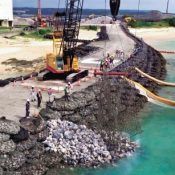
November 7, 2017 Ryukyu Shimpo
On November 6, the Okinawa Defense Bureau (ODB) of the Ministry of Defense (MOD) undertook construction of two new seawalls related to construction of a replacement facility for Futenma Air Station at the planned site in Henoko, Nago City.
This construction in question is embankment work on the K1 and N5 seawalls, located in two spots in the southwest of the land reclamation area.
The seawalls are intended to enclose the land reclamation area.
Last summer, the Japanese government completed a part of seawall in one fixed section of the land reclamation area, and has now indicated that soil and earth is being hauled there to start filling that section.
In light of the Okinawa Prefectural Government (OPG) providing administraitive guidance that construction be suspended and filing a lawsuit against reef crushing activity by the Japanese government, this new move to push construction will presumably make backlash from Okinawans even stronger.
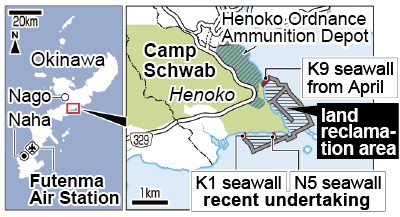
Just past 10:00 a.m. on November 6, the ODB began construction of the K1 seawall which will form the border of the land reclamation area on the southwest side of Cape Henoko, and the N5 seawall which will form a partition within the area.
A bit past 10:30 a.m. the same day a crane was observed in the N5 section lowering crushed stone into the ocean, and in the K1 area crushed stone was being dropped onto the beach. On the water, citizens protesting new base construction from protest boats have been chanting the words: “Don’t destroy the blue ocean any more.
” In July, the OPG brought a lawsuit against the Japanese government on grounds of it advancing construction illegally without reef crushing approval from Okinawa’s governor.
Okinawa’s governor provided administrative guidance in October, requesting that the Japanese government suspend construction and engage in consultations with the OPG over coral conservation measures and using maritime transport for K9 embankment work.
However, the ODB is forcing construction through without heeding this guidance.
Construction on the K9 seawall first began in April. The seawall is by plan supposed to extend about 300 meters in all, but at about one-third of the planned wall, or 100 meters into the ocean, progress halted.
From here on, instead of transporting stones and construction materials by land, the ODB is planning to speed up construction by making use of the seawall as a docking place for boats and barges, so that stones can be hauled over the water.
(English translation by T&CT and Erin Jones)
Go to Japanese

November 3, 2017 Ryukyu Shimpo
Approximately twenty Hawaiians with Okinawan ancestry visited the Chibichirigama in Yomitan Village on November 1, where a group of young men had vandalized the natural cave. The group played Kwamucha-bushi and made offered up origami cranes and Hawaiian leis in a prayer for peace. The group also visited the Shimukugama, where a thousand residents were saved by two people who had returned from Hawaii and were able to communicate in English. The group reaffirmed the bond between Okinawa and Hawaii.
The visiting group consists of members from a Ryukyuan performance group called Ukwanshin Kabudan. The members of the group are third and fourth generations of Okinawan immigrants to Hawaii, and they have kept alive their Okinawan culture through musical performance and Okinawan languages. They also conduct an annual study tour, bringing Okinawan-Hawaiians to Okinawa to learn about Okinawan history and culture.
Sixty-nine-year old former village assembly member, Shoichi Chibana, led the group and explained that the cave was damaged by young men in September.
Fourty-two-year old third generation Okinawan-Hawaiian, Norman Kaneshiro, performed Kwamucha-bushi, a song about the sorrow of losing a loved child. He shared his thoughts, “I performed the music thinking about the people of Okinawa whose feelings are hurt, and I shared their feeling, being also Uchinanchu and an islander.”
The group learned about the history of the Shimukugama, where two residents who had returned from Hawaii and understood English, saved the one thousand people hiding in the cave. The group will host a concert at the Okinawa Christian University main chapel on November 4 from 5pm to 6pm. The concert is free.
(English translation by T&CT and Sayaka Sakuma)
Go to Japanese

November 3, 2017 Ryukyu Shimpo
Due to typhoons numbers 21 and 22, the ferry from the main island of Okinawa was unable to make its delivery to Minamidaito and Kitadaito Villages since October 15.
On November 2, for the first time in 18 days, the ferry arrived at the ports.
The villagers sighed with relief since there was a shortage of food at both villages.
Meanwhile, some stores were unable to keep up with the volume of the incoming goods.
According to a spokesman from the JA Okinawa Kitadaito Lifestyle Store, after the ferry arrived at the port at 7 a.m., vegetables and dairy products were restocked at the store around 8 am. Cashiers were unable to keep up with the long lines and by noon, most of the vegetables had sold out.
A female worker at the store said, “I’m really glad the food arrived. I’m relieved that sales went up too.”
Many customers arrived at the Miyagi Yukie Shop on the south side of Kitadaito Village just as the shop opened at 8 a.m.
While being surprised that the price of vegetables had soared due to the typhoon, customers were seen smiling with vegetables in hand.
The ferry arrived at Minamidaito Village at 10 a.m. At A-Coop Minamidaito Store, the amount of supplies coming in was so much that it was not until the afternoon that the vegetables were restocked.
Some customers, who had arrived in the morning in hopes of buying vegetables, were forced to come back in the afternoon.
Both villages had been utilizing the air transport subsidy project for bread, milk, tofu, and eggs that started this summer.
But the items would sell out the moment they were restocked.
(English translation by T&CT and Chelsea Ashimine)
Go to Japanese
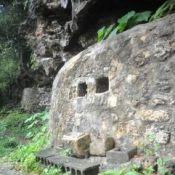
November 1, 2017 Ryukyu Shimpo
Taiwan University will return the remains of Ryukyuan people that were found in Mumujana grave in Nakijin Village by anthropologists from the former Imperial Universities in the early Showa era and are being kept at the university.
The Nakijin Village Board of Education and the Okinawa Prefectural Board of Education announced on October 31 that they have started working on the process for returning the remains.
They have not yet decided on the timing of the return.
Taiwan University indicated its intention to return 63 Ryukyuan people’s remains currently stored at the university.
As Nakijin Village and the Prefecture have expressed their wish to accept the offer, the exchange will take place.
The Nakijin Village Board of Education consulted with Taiwan University and began considering the offer in early October.
The Village Board of Education and the Prefectural Board of Education are planning to inform Taiwan University in writing of their intention to accept the remains.
After they are returned, the remains will be kept in facilities in the prefectural office building.
A village board of education official said, “We will consult with the prefecture about the safekeeping of the remains.
We do not know when they will be returned.
We are in the process of confirming details.
” The Prefectural Board of Education Cultural Property Division said, “We are looking for places where remains can be stored securely with proper temperature and humidity management.
We will respect the village’s wishes and respond.”
Civic groups and researchers who have been calling for the return of the remains are demanding proper reburial.
They say the remains should not be treated merely as material for research.
The Nakijin Village Board of Education is also planning to contact Kyoto University, which also stores Ryukyuan remains.
Kyoto University has not yet revealed whether it will return the remains or not.
(English translation by T&CT and Megumi Chibana)
Go to Japanese
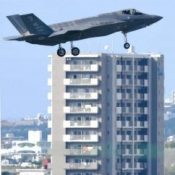
November 3, 2017 Ryukyu Shimpo
(Central Okinawa) On November 2, ten F-35As, one of the U.S. Air Force’s newest stealth fighters, arrived at Kadena Air Base. The F-35As are normally stationed at Hill Air Force Base in Utah. The 18th Wing of the U.S. Air Force stationed at Kadena Air Base has announced that a total of twelve aircraft, including the ten that recently arrived, and 300 personnel will be temporarily stationed at Kadena for six months. The other two aircraft had already arrived on October 30, and the temporary deployment of new aircraft at Kadena is now complete.
This is the first time the F-35A has been operated in the Indo-Asia-Pacific region. According to the Okinawa Defense Bureau, there has been no notification from the U.S. military regarding when training using these aircraft will start, but it is expected to start on November 3 or later. There are concerns that this will cause an increase in noise suffered by nearby residents.
The “Three-City/Town Liaison Council on U.S. Military Kadena Air Base” (Three-Party Council), comprising representatives from Okinawa City, Kadena Town, and Chatan Town, had protested to the U.S. military and the Okinawa Defense Bureau and demanded that the aircraft not be deployed.
Kadena Mayor Hiroshi Toyama expressed anger at the deployment of the twelve new aircraft, saying, “I do not accept flights by aircraft brought in from the outside, and the F-35 fighter in particular causes extreme noise; I am concerned that this will increase harm [to residents]. I want them to be removed with haste.”
The F-35s arrived in two groups of five aircraft over the course of one hour, starting around 3 p.m. The aircraft circled overhead before landing, producing loud noise.
Members of the Kadena local government measured noise of 92.9 decibels on the roof the town office at 3:04 p.m. when the F-35s flew overhead. 90 decibels is approximately the level of noise heard inside a loud factory.
The Three-Party Council plans to do a visual survey of the F-35 operation going forward and visit the Ministry of Defense and Ministry of Foreign Affairs to protest at the end of November.
Since October 31, there have been daily flights at Kadena Air Base of FA-18 Hornets belonging to Iwakuni Air Station. On November 1, eight FA-18s were located at Kadena and conducted training there until around 9 p.m. Although all the aircraft returned to Iwakuni on November 2, two new ones arrived on the same day.
(English translation by T&CT and Sandi Aritza)
Go to Japanese

November 6, 2017 Ryukyu Shimpo
By Yukiyo Zaha
Washington D.C. – The Washington Okinawa Kai (Itsuko Asato, president), formed by Okinawans and their descendants living in Washington D.C. and surrounding areas, celebrated the October 30 anniversary “World Uchinanchu Day,” from October 28-30, hosting dinners in five areas including Washington D.C., Virginia, Pennsylvania, and Maryland. Members from different generations gathered to celebrate, enjoying activities like Okinawa-themed quiz games.
Around 40 people joined the dinner in Chantilly, Virginia, where they enjoyed dinner and conversation.
Hiromi Uehara, originally from Agena in Uruma City, who came to the United States as an exchange student to George Washington University in 1960 and has been working at the Japanese Embassy in Washington D.C. for 38 years, said, “It was a lot of fun. Even after all these years, I am still an Okinawan.” Fujiko Hutchins, originally from Ginowan, said, “I am proud to be Uchinanchu.”
(English translation by T&CT and Sam Grieb)
Go to Japanese

November 1, 2017 Ryukyu Shimpo
It came to light on October 31 that the Ministry of Defense (MOD) and Self-Defense Forces (SDF) are considering Camp Hansen in Okinawa as a potential place to deploy the Amphibious Rapid Deployment Brigade (ARDB), a unit of the Ground Self-Defense Forces (GSDF) that will be established in March next year.
Several people involved in the process disclosed this information.
About 8,000 Marines currently stationed in Okinawa are to be relocated to Guam and elsewhere outside Japan during the first half of the 2020s.
It appears this relocation will be incorporated in the upcoming period of the Mid-Term Defense Program (MTDP).
If Self-Defense Forces are deployed to Camp Hansen, the relocation of Marines will be a reduction of Okinawa’s base burden in name only.
It is inevitable that local residents, who have not agreed to this plan, will oppose it.
According to an MOD official, the Minister for Foreign Affairs and Minister of Defense said in their joint statement concerning the U.S.-Japan Security Consultative Committee (2+2) that they have reaffirmed that the SDF posture would be strengthened to promote joint use of bases especially in Japan’s southwestern islands.
The ministers also said that there have been discussions concerning joint use of U.S. bases in Okinawa such as Camp Hansen.
The U.S.-Japan Roadmap for Realignment Implementation agreed upon by the U.S. and Japanese governments in May 2006 states: “Camp Hansen will be used for Ground SDF training.”
Already the number of drills conducted by the SDF is increasing, but Marines stationed in Okinawa moving outside Japan will free up base capacity to conduct operations.
For that reason, it seems plausible that SDF use of U.S. facilities may increase.
The ARDB has been referred to as Japan’s version of the Marine Corps.
It is being formed for the purpose of island recapture operations, among other functions, in light of tensions over the Senkaku Islands.
It has been determined that Osprey aircraft will be introduced into the ARDB, and training could be conducted on remote islands in Okinawa.
Next year in March about 2,100 people will form two regiments of the ARDB, which will be deployed to GSDF Camp Ainoura in Nagasaki Prefecture.
The initial plan was for approximately 3,000 people to form three regiments, but deploying the remaining regiment to Camp Hansen is still under consideration.
Aside from the MOD being undecided on whether or not to form a third regiment, another part of the U.S.-Japan Roadmap remains uncertain.
An MOD official voiced concern over work related to relocation of U.S. Marine Corps Futenma Air Station, such as the construction of a replacement facility in Henoko, Nago City.
The official said it might be difficult to accomplish, due to local citizens’ sentiments opposing U.S. base construction.
(English translation by T&CT and Erin Jones)
Go to Japanese

October 27, 2017 Ryukyu Shimpo
On September 28, Taizo Shibano, a 42-year-old executive of La Vous, a gelato shop in Ginowan City that uses locally-sourced Okinawan ingredients, was awarded first place in the Gelato World Cup held in Italy. Now that Taizo is the first Japanese to win top prize among 45 other competitors he sets his sights on the next goal stating, “Becoming the best in the world is just a checkpoint in my desire for gelato to take root in Japanese culture.”
The Sherbeth Festival was held in Palermo, Italy from September 28 to October 1. After passing an initial screening, 45 individuals took part in the competition through a display of their gelato-making abilities and presented their creations in Italian. Gelato shop manager Katsuya Yonemori, 22, was knighted by the Italian Gelato Association with an awarding ceremony scheduled to be held later in January, 2018.
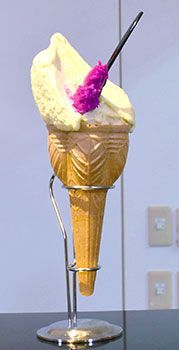
Winner Taizo Shibano at the Gelato World Cup (right) and Katsuya Yonemori who was knighted, taken on October 26 at La Vous in Kakazu, Ginowan City.
Just prior Shibano participated in another competition winning fourth place for his creation “Pineapple, apple, celery.” Its focus was built on three pillars: health, being able to cleanse and freshen one’s palate, and creativity. Although the ingredient of celery aids digestion and makes a fine palate cleanser during consumption it is not a taste found enjoyable in Italy. Shibano had to adjust the proportion ratio to pursue a more favorable balance for the audience. It proved successful as he received first place from the popular vote and praise from the judges who said his creation was the “tongue of God” and that “your theory proved to be correct.”
As a second-generation dairy farmer hailing from Ishikawa Prefecture, Shibano began with a hope stating, “I want to bring out the good qualities of locally-sourced ingredients and create products that will become economic drivers.”
Shibano’s focus, however, remains local and refuses to expand into the Tokyo market explaining, “Okinawa is abundant with enticing ingredients, such as guava, acerola, etc. and I wish to bring out their natural flavor in my gelato creations.”
The operating company of La Vous has signed into a consulting contract with a Hong Kong businessman and is preparing to open its own Okinawan-styled gelato shop in April, 2018.
(English translation by T&CT and Norbert Bartczak)
Go to Japanese

November 2, 2017 Ryukyu Shimpo
Participant registration for the 1st Okinawa Karate International Tournament, which will be held starting August 1, 2018, began on November 1.
Including both the competitions and seminars, the tournament is aiming for between 5,000 and 6,000 participants. The same day, representatives from Okinawa Prefecture and the Okinawa Dento Karatedo Shinkokai, who will co-host the tournament, put out the call to, “gather at the birthplace of Karate,” at a press conference.
Registration is 3,000 yen.
Participants must register on the tournament’s homepage: http://okinawa-karate.okinawa.
The deadline for registration for Okinawan residents is January 31, 2018; for those outside of Okinawa, the deadline is March 31, 2018.
If the executive committee decides that online registration is too difficult, they may decide to also allow mail-in and in-person registration as well.
Qualification for those inside Okinawa will be March 23-24, for outside of Okinawa qualification is August 2-3.
On August 6 and 7, there will be seminars teaching traditional Karate technique.
Seminars are open to everyone, not just people participating in the competition.
Seminars are limited to 50 people each, and participants must apply and pay the 3,000 yen registration fee.
Choko Kiyuna, president of the Okinawa Dento Karatedo Shinkokai, said, “Our peace-loving ancestors developed Karate.
I hope that the tournament will provide a chance for many Karate-ka to come to Okinawa.”
(English translation by T&CT and Sam Grieb)
Go to Japanese











 Webcam(Kokusai Street)
Webcam(Kokusai Street)


